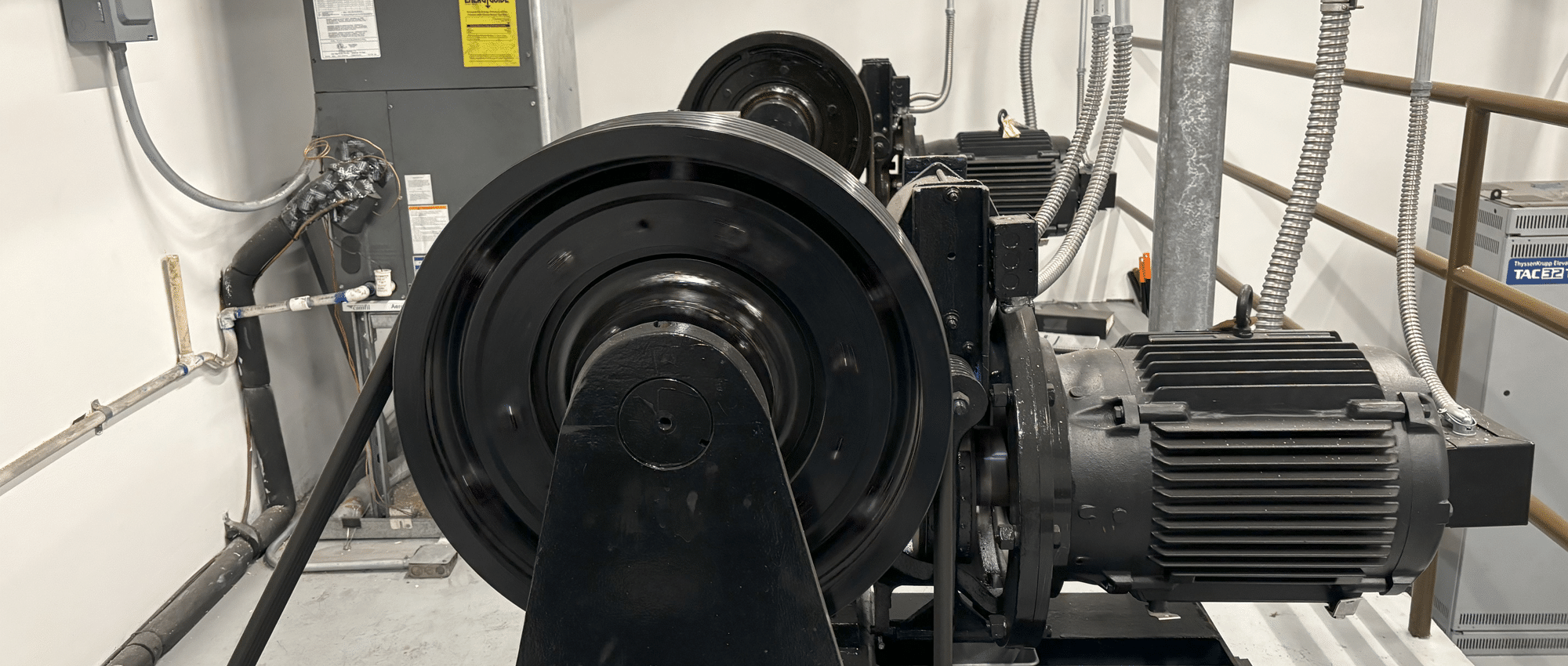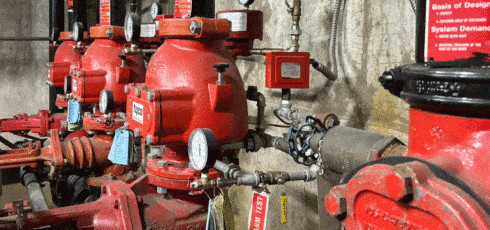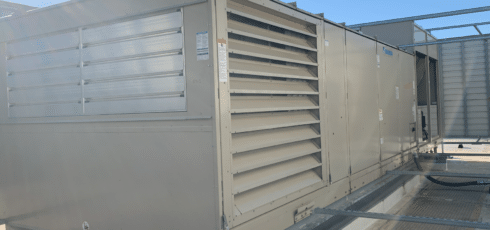Elevators are the unsung heroes of modern commercial buildings, quietly transporting thousands of people every day without much thought from the average passenger.
Read Next: What Are the Different Types of Elevator Systems for Commercial Properties?
However, behind the scenes, building engineers and elevator technicians work tirelessly to ensure that these complex machines remain safe, reliable, and efficient. From regular maintenance and inspections to modernization projects and emergency rescues, maintaining your building’s elevators is critical to the smooth operation of any commercial property.
In this article, we’ll explore:
- Elevator maintenance
- Safety inspections
- Common elevator issues and solutions
- Modernization and upgrades
- Advancements in elevator technology
- Photos of elevator systems
Elevator Maintenance
Effective elevator maintenance involves both preventive and corrective measures. Preventive maintenance focuses on regular inspections, lubrication, cleaning, adjustments, and calibrations to keep elevators running smoothly and prevent breakdowns. Building engineers work closely with elevator maintenance contractors to schedule and oversee these tasks, ensuring that all components are functioning optimally.
Read Next: Deferred Maintenance in Commercial Property Management: The Snowball Effect
Corrective maintenance, on the other hand, addresses issues as they arise. When an elevator malfunctions or shows signs of wear, building engineers work with elevator technicians to quickly identify the problem and take appropriate action. This may involve replacing worn or damaged components, such as cables, pulleys, or door operators, to restore proper operation and prevent further damage.
Elevator technicians are responsible for maintaining and testing various components of commercial elevators to ensure safe, reliable, and efficient operation, including:
- Doors and Door Operators: Inspect, adjust, and test door components to ensure smooth, quiet, and safe operation.
- Cables and Sheaves: Inspect cables and sheaves for wear, alignment, and lubrication, replacing as needed.
- Brakes and Safety Devices: Test and maintain emergency brakes and safety devices for proper function and smooth operation.
- Control Systems and Sensors: Test, calibrate, and update control systems and sensors to maintain optimal performance and accuracy.
- Hydraulic Systems: Inspect hydraulic fluid, lines, cylinders, and safety components for leaks and proper function.
Building engineers are responsible for maintaining and testing various components of commercial elevators to ensure safe, reliable, and efficient operation, including:
- Sump Pumps: Inspect, test, and maintain sump pumps to ensure proper drainage and prevent water damage in elevator pits.
- Communication Systems: Test emergency phone and intercom systems weekly to ensure clear, reliable communication.
- Machine Room Equipment: Inspect, clean, and maintain machine room equipment, ensuring proper temperature and humidity levels.
- Signage and Accessibility: Ensure clear, compliant signage and maintain accessibility features for all users.
- Hoistway and Pit: Inspect hoistway walls, doors, and pit areas for cleanliness, damage, and proper safety equipment function.
AQUILA Pro Tip
Maintenance Contracts
To ensure that elevators are properly maintained, building owners and managers typically enter into a maintenance contract with an elevator company. For newer elevators, it is common to use the manufacturer for the maintenance contract. However, for older elevators, it is possible to switch to a different company.
Read Next: How to Extend the Life of Your Commercial HVAC System
Safety Inspections
Regular safety inspections are crucial for maintaining the integrity and reliability of commercial elevators. The frequency of these inspections is typically governed by local and state regulations.
During a safety inspection, building engineers and elevator maintenance professionals thoroughly examine all aspects of the elevator system, including mechanical components, electrical systems, and emergency features like brakes, alarms, and communication devices. They check for wear, damage, and proper functioning, making necessary repairs or adjustments to ensure the elevator meets all safety requirements.
Read Next: How to Choose the Right Commercial Property Management Company
Accurate documentation and reporting are essential aspects of safety inspections. Building engineers must maintain detailed records of all inspections, repairs, and maintenance activities, providing a clear audit trail and demonstrating compliance with relevant regulations.
Common tests and inspections include:
- Weekly tests: These tests involve checking the elevator’s phone system to ensure that it is functioning properly in case of an emergency.
- Monthly tests: Fire recall tests are conducted monthly to ensure that the elevator responds correctly to a fire alarm signal and returns to the designated floor.
- Annual inspections: An annual inspection is performed by the elevator company that holds the maintenance contract. This inspection is a comprehensive examination of the elevator’s components, including the control system, drive machine, and safety devices.
- Five-year load tests: Every five years, a load test is conducted to ensure that the elevator can safely transport its rated load capacity. This test involves placing weights in the elevator and verifying that it functions correctly under load.
AQUILA Pro Tip
Special Considerations
In addition to regular maintenance and inspections, building engineers must also be aware of special considerations related to elevator systems. For example, elevators with a travel distance of less than 15 feet, known as “two-stop” elevators, are exempt from many of the standard regulations governing elevator operation and maintenance. However, building engineers must still ensure that these elevators are safe and functional.
Read Next: What Are the Different Types of HVAC Systems for Commercial Buildings?
Common Elevator Issues and Solutions
Despite regular maintenance and inspections, elevators can still experience various issues that require attention from building engineers and elevator techs. Some common problems include:
- Door malfunctions: Elevator doors may fail to open or close properly, posing safety risks and causing inconvenience to users. Elevator techs diagnose and repair door issues promptly, often by adjusting or replacing door operators, sensors, or tracks.
- Leveling problems: If an elevator fails to stop level with the floor, it can create tripping hazards and accessibility issues. Leveling problems may stem from issues with the elevator’s control system, sensors, or mechanical components, requiring careful adjustment or repair.
- Unusual noises or vibrations: Strange sounds or excessive vibration during elevator operation can indicate underlying mechanical issues, such as worn bearings, loose components, or imbalanced loads. Building engineers and elevator techs must investigate these issues and take corrective action to prevent further damage and ensure smooth operation.
- Entrapments and rescues: In rare cases, elevators may malfunction, trapping passengers inside. Building engineers and elevator techs must be prepared to respond quickly to entrapment situations, following established protocols for passenger communication, maintenance staff coordination, and safe rescue procedures.
Read Next: Cost to Hire a Commercial Property Management Company in Austin, TX (Fees/Rates)
Modernization and Upgrades
As commercial buildings age and technology advances, elevator modernization and upgrades become increasingly important. Building engineers may recommend modernization projects to improve energy efficiency, enhance safety features, or meet new building codes and regulations. This is particularly crucial for older elevators, as many parts may no longer be available, making repairs and maintenance more challenging.
Fire Compliance
Fire compliance is another critical factor driving elevator modernization. Older elevators may not have the necessary fire safety features, such as fire recall systems, which automatically return the elevator to a designated floor in the event of a fire. While most elevators have been updated to meet current fire safety standards, some may still require modernization to ensure compliance.
Read Next: An In-Depth Look at Commercial Building Fire Protection Systems
Energy Savings
One of the significant advantages of modern elevators is their energy efficiency. Older elevators require air conditioning in the machine room to keep the equipment cool, but newer elevators generate less heat, eliminating the need for additional cooling. This can result in significant energy savings for building owners.
Read Next: Building Automation Systems: Enhancing Efficiency and Comfort in Commercial Buildings
Modernizing Process
Modernization projects can be time-consuming, often taking up to six months to complete, as new elevators need to be built and installed. However, the benefits of modernization are significant, including improved reliability, enhanced safety features, and increased energy efficiency.
Retrofit solutions, such as replacing outdated control systems, upgrading door operators, or installing new safety devices, can often extend the life of an existing elevator and improve its performance. In some cases, however, full replacement may be necessary to ensure the long-term reliability and safety of the elevator system.
Advancements in Elevator Technology
In recent years, elevator technology has made significant strides, offering improved functionality, enhanced safety features, and increased energy efficiency. Some notable advancements include:
- Destination dispatch systems: These systems allow passengers to select their desired floor before entering the elevator, optimizing traffic flow and reducing wait times. Examples of such systems can be found at the Mueller Business District and Eastlake at Tillery, where elevators are programmed only to stop at authorized floors for each passenger.
- Touch display controls: Modern elevators, such as those found at Braker Pointe III, feature user-friendly touch displays for selecting floors and accessing information, enhancing the passenger experience.
- Energy-efficient designs: Newer elevators are designed to be more energy-efficient, often eliminating the need for machine room air conditioning. This is because modern machinery generates less heat, resulting in significant energy savings and reduced environmental impact.
- Improved safety features: Advanced elevators incorporate a range of safety features, such as door sensors, emergency brakes, and improved communication systems, to ensure passenger safety and minimize the risk of accidents or entrapments.
Read Next: 5 Benefits of Using a Property Management Company to Manage Your Office Building
Photos of Elevator Systems
Conclusion
Commercial elevator maintenance and safety inspections are essential for ensuring the reliable, efficient, and safe operation of these critical building systems. By adhering to regular maintenance schedules, conducting thorough safety inspections, and promptly addressing any issues that arise, building engineers and elevator technicians play a vital role in protecting the well-being of building occupants and maintaining the long-term value of commercial properties.
Read Next: Best Commercial Property Management Firms in Austin, Texas
As technology continues to advance and regulations evolve, the ongoing commitment of building engineers and elevator technicians to elevator safety and performance remains paramount. Through their expertise, diligence, and proactive approach, these professionals help keep commercial buildings running smoothly and safely, one elevator ride at a time.
Contact us today to discover how our property management team and building engineers can enhance your building’s operations and tenant satisfaction.



















